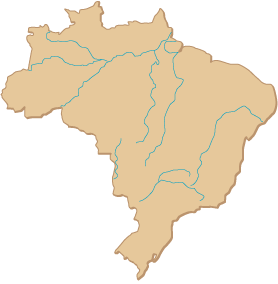Brazil: Introduction
 |
 |
Physical geography
Brazil is the fifth largest country in the world and makes up about half of the continent of South America. Brazil’s topography ranges from the Amazon Basin to the Brazilian Highlands. The Amazon Basin lies on 7,049,975 km2, which amounts to forty percent of South America's total area. The Amazon River is the second longest river in the world, at 6,436 km it is second only to the Nile; however, the Amazon River is the largest by volume. The highest point in Brazil is Pico de Melina at 9888 feet. Brazil is so large every country in South America borders it except for Ecuador and Chile.Political geography
Brazil is divided into one Federal District and twenty-six states. The capital is Brasilia and has city of Brazil is Brasilia.
Urban Geography
The population of Brazil is 188 million. Sao Paulo has a population of 10.8 million while Rio de Janeiro has a population of 6.1 million. These two cities are included as two of world's fifteen largest cities. Both cities have many large and expanding faceless (shanty towns) on their peripheries.
People
Portugal began to colonize Brazil in 1500. Portugal brought slaves from Africa to Brazil and established plantations. Brazil proclaimed its independence in 1822 and is the only Portuguese speaking nation in South America. Today, Brazilian society is made up of descendants of migrants from Europe, Africa, and Asia. Within Brazil there are 300,000 indigenous people grouped into 200 tribes. The current population of Brazil is 188 million with a 1.04% population growth rate. São Paulo is the world’s second largest city with over fourteen million residents. The vast majority of Brazilians are Roman Catholic. There are shortages of houses and jobs, poverty is widespread and sanitation is poor. Many children live in the streets. Almost 700,000 Brazilian are living with HIV/AIDS. The climate allows for Brazilians to spend a lot of time outside, among lots of people. This may be why Brazilians are known for their sociable, outdoor way of life.
Economy
Brazil has the ninth largest economy in the world and was expected to grow 2.7% in 2006. [Note: This report was written in November 2006. — Danny Catt.] Roughly one third of the workforce is involved in agriculture. The state of Sao Paulo leads the Brazilian economy and is responsible for half of the country’s GDP as well as two-thirds of its manufacturing. Brazil is the leading coffee producer in the world and produces a quarter of the world citrus and one-fifth of the iron ore. Sugar cane is produced mostly to create gasohol which powers many Brazilian automobiles. Cattle, pigs, and sheep are the most numerous livestock. Timber is important, but much of it is illegally harvested. Only five percent of the Brazilian land is cultivated. The biggest industry in Brazil is automobile production.
 Funded by TEK
Funded by TEK